Comparison of Different Turbulence Models on Sediment Transport in the Open Channel Test Case
Introduction
Sediment transport in open channel flows is influenced by turbulence, which governs the distribution of momentum and sediment throughout the water column.
EEMS 12 was employed to simulate the effects of different turbulence models on sediment transport. Starting from EEMS version 12, users have the flexibility to construct models using turbulence closures sourced from GOTM (General Ocean Turbulence Model) for vertical turbulence, in addition to the original EFDC+ options. This flexibility enables users to choose turbulence closure models (k-ε, k-ω, MY25) within a consistent numerical framework.
This blog investigates the performance of three turbulence closure models—k-ε, k-ω, and MY2.5—using a three-dimensional numerical simulation. The focus is on how these turbulence models affect critical aspects of sediment transport, such as bed shear stress, and total suspended solids (TSS). We analyze the implications of these models in an open channel test case, where flow is steady, homogeneous, and influenced by resuspension and diffusion of sediment. The turbulence settings of the three models are as shown in Figure 1.
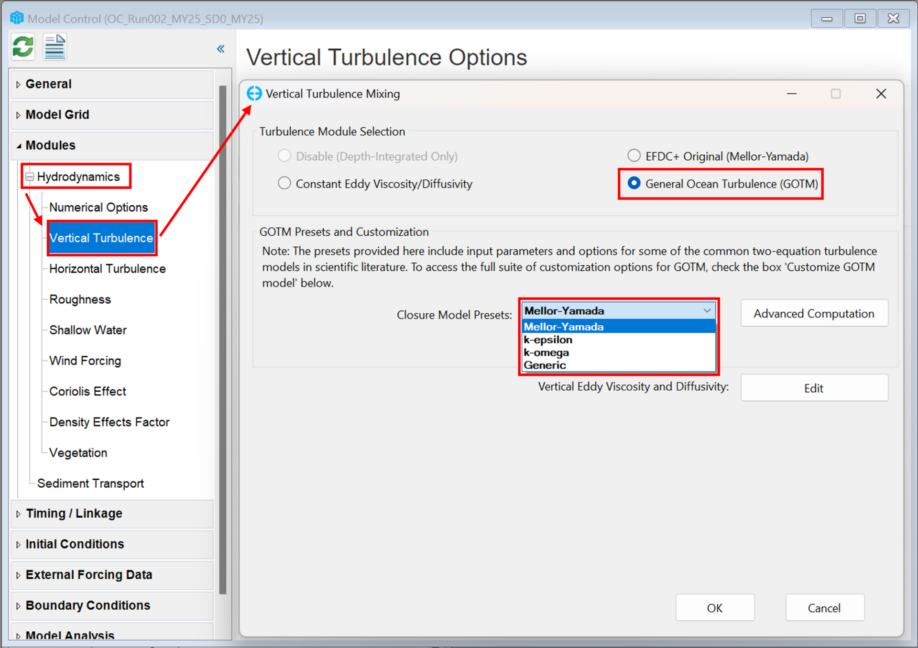
Model Description
The physical dimensions of the numerical model are specified as: Length (L), Width (W) = 1000, 50 m, respectively; Bed Slope i = 0.001 m/m; horizontal grid dimensions dX, dY = 5, 5 m; bottom roughness zr = 0.001 m; and the number of vertical layers = 40. The upstream model boundary conditions were specified using a flow boundary condition, whereby the total flow was distributed uniformly with depth. The downstream model boundary was configured using a specified water surface elevation (free tangential).
The sediment model has three sediment layers with four sediment classes including two cohesive and two non-cohesive classes. The erosion and deposition parameters used for cohesive and non-cohesive sediments are shown in Tables 1 and 2.
Table 1. Non-Cohesive sediment parametrization
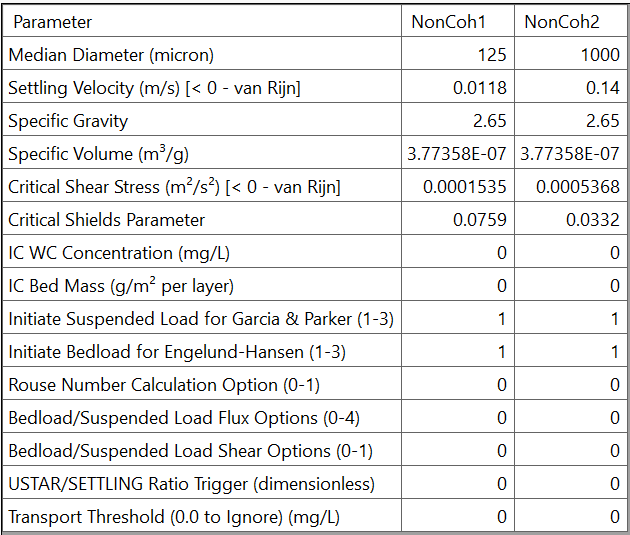
Table 2. Cohesive sediment parametrization
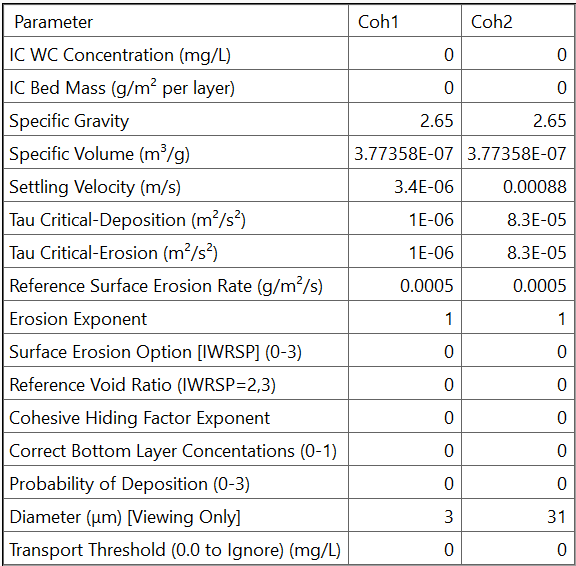
Bed Shear Stress
The bed shear stress is a crucial factor for sediment resuspension. Among the models, the k-ω scheme showed the highest shear stress. The MY2.5 model exhibited lower shear stresses, while the k-ε model was intermediate (Figure 2). The differences in bed shear stress directly influence the resuspension rates of sediment, with k-ω promoting the most vigorous resuspension.
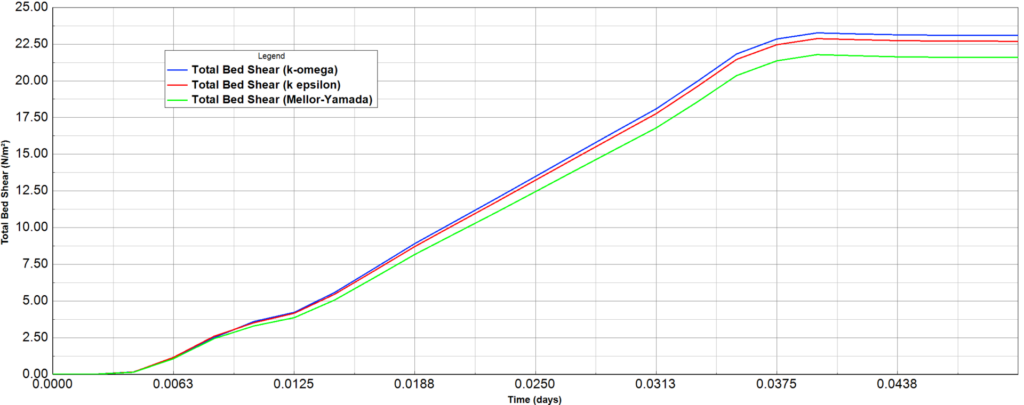
Total Suspended Solids (TSS)
The distribution of TSS was found to be sensitive to the choice of turbulence model, as it is strongly tied to the vertical mixing and resuspension dynamics. The k-ω model resulted in the highest concentrations of suspended sediments (Figure 3), due to its higher bed shear stress (Figure 2) and more efficient vertical mixing. In contrast, the MY2.5 model produced lower concentrations of TSS, with less effective mixing of sediments throughout the water column. The k-ε model yielded results between these extremes. Figure 4 shows the Modeled suspended-sediment concentrations along a transect, as shown the difference between the 3 GOTM turbulence cases is not very big but k-ω has the biggest TSS.
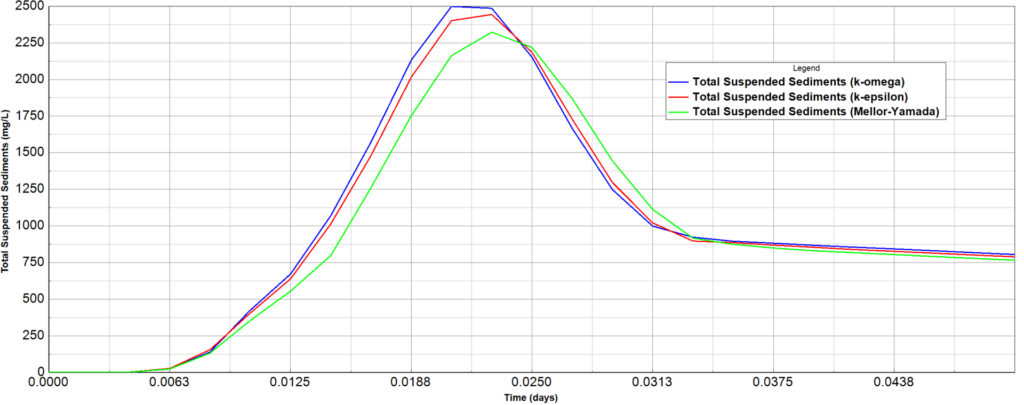

Discussion
The selection of a turbulence model impacts the simulation results for sediment transport in open channels. The k-ω model stands out for its superior handling of boundary layers and bed shear stress, making it ideal for cases where near-bed processes dominate sediment dynamics. However, this comes at the cost of computational intensity. The k-ε model, while less accurate in these regions, remains a practical choice for larger-scale applications due to its simplicity and computational efficiency.
Do you want to try these options for yourself? You can start by downloading EEMS, activating the free demo mode, and then running our demonstration models. To see these features in action, head over to our YouTube page.
Please get in touch with us if you have any comments or questions. For more information on EFDC+ capabilities, contact the DSI team today.
Talk to the experts
References
DSI LLC. 2024. EFDC+ Theory, Version 12. Published by DSI LLC, Edmonds, WA. Available at https://eemodelingsystem.com/wpcontent/Download/Documentation/EFDC Theory Document Ver 12.pdf







